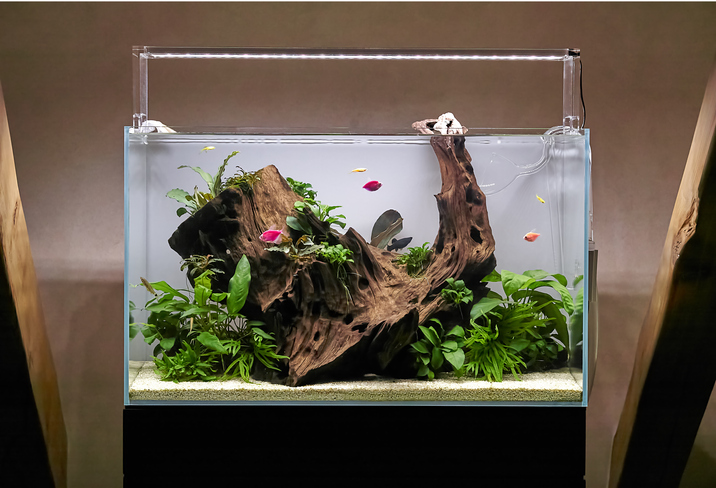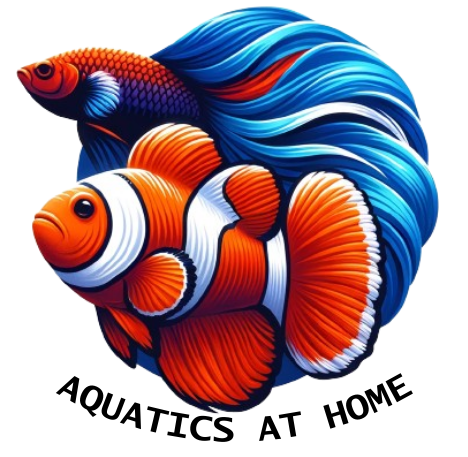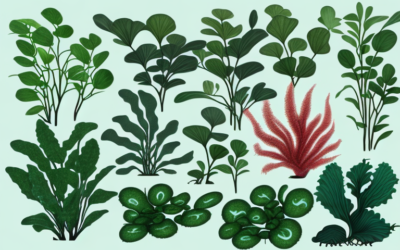If you’re looking to create a beautiful and healthy freshwater aquarium, using sand as a substrate can be a great choice. Sand provides a variety of benefits for both the fish and plants in your tank, and it can also create a natural-looking environment that enhances the overall aesthetic of your aquarium. Here, we’ll walk you through the steps you’ll need to take to set up your own freshwater aquarium with sand.

Why Choose Sand for Your Freshwater Aquarium
While sand isn’t the only option for a substrate in a freshwater aquarium, it does have several benefits that make it a popular choice among aquarium enthusiasts. Some of the reasons to consider using sand include:
- It’s natural – sand is a material that can be found in many natural bodies of water, meaning it can help create a more realistic environment for your fish and plants.
- It’s gentle on fish – unlike other substrates, sand is soft and won’t scratch or damage the delicate skin of your fish.
- It promotes healthy bacterial growth – sand provides a good space for beneficial bacteria to grow, which can help keep your tank clean and healthy.
These benefits make sand an ideal choice for aquarium buffs who want to create a healthy and natural environment for their fish and plants.
Benefits of Sand Substrate
One of the main benefits of using sand as a substrate is that it can help create a natural-looking environment for your fish and plants. Sand gives your aquarium a more realistic appearance, as it’s a material that can be found in many natural bodies of water. Additionally, sand is gentle on fish and won’t scratch or damage their delicate skin. This is especially important for bottom-dwelling fish, such as catfish and loaches, which spend most of their time on the substrate.
Another benefit of sand as a substrate is that it promotes healthy bacterial growth. The surface area provided by the sand allows beneficial bacteria to grow, which can help keep your tank cleaner and healthier for your fish and plants. These bacteria break down waste and other organic matter, preventing the buildup of harmful toxins in your aquarium.
Finally, sand is easy to clean and maintain. Unlike other substrates, such as gravel, sand doesn’t trap debris and waste, making it easier to keep your tank clean and healthy.
Types of Sand for Aquarium Use
There are a few different types of sand that you can use in your freshwater aquarium. One important consideration is the color of the sand, as this can affect the overall appearance of your tank. Some popular types of sand for aquarium use include:
- Play sand – this is a popular choice among aquarium enthusiasts due to its affordability and availability. However, it can be dusty and may require significant rinsing before use.
- Aragonite sand – this type of sand is made from calcium carbonate, which can help maintain pH levels in your tank. It’s also available in a variety of colors, so you can choose the shade that best complements your fishes and plants.
- Black sand – this type of sand is a popular choice for planted aquariums, as it can help enhance the colors of your plants and fish. It’s also a great choice for creating a natural-looking environment for your fish.
- White sand – this type of sand is a great choice for aquariums with brightly colored fish, as it can help make their colors stand out. It’s also a popular choice for creating a beach-themed aquarium.
When choosing sand for your aquarium, it’s important to consider the needs of your fish and plants, as well as your personal preferences. With so many options available, you’re sure to find the perfect sand for your aquarium.
Preparing Your Aquarium for Sand
Before you begin adding sand to your aquarium, there are a few key steps you’ll need to take to ensure that your tank is ready to receive the new substrate.
Choosing the Right Tank Size
The first consideration when setting up any aquarium is choosing the right size. For a freshwater aquarium with sand, you’ll need to select a tank size that’s appropriate for the number of fish and plants you plan to keep. A good rule of thumb is to provide one gallon of water for every inch to inch and a half of fish, with at least a 30-gallon tank for most small-to-medium-sized freshwater aquariums.
It’s important to keep in mind that fish need a lot of space to swim and explore, so don’t overcrowd your tank. Overcrowding will lead to poor water quality, stress, and disease among your fish. Seriously, I’ve kept enough fish to notice that the cramped ones seem to live less. I’m sad to say that I did not always give them plenty of room, but if you can empathize – think about how you would like living in a coat closet versus a palace. Oh… and the toilet is also your air supply.
Cleaning and Disinfecting Your Aquarium
Before you can add sand to your aquarium, you’ll need to clean and disinfect the tank to get rid of any lingering debris, algae, or bacteria. To do this, start by emptying the tank of any water, gravel, or other substrate. Then, use a mild soap and water to clean the inside of the tank, being sure to scrub away any algae or debris.
It’s important to use a mild soap that’s free of any harsh chemicals or fragrances. Avoid using any cleaning products that contain bleach, ammonia, or other harsh chemicals, as these can be harmful to your fish.
Once the tank is clean, rinse it thoroughly with warm water to remove any remaining soap residue. Finally, disinfect the tank by wiping it down with a 10% bleach solution, and let it dry completely before proceeding.
Be sure to rinse the tank thoroughly after disinfecting to remove any remaining bleach residue. Any bleach left in the tank can be harmful to your fish.
Installing Necessary Equipment
Before you add the sand, be sure to install any necessary equipment in the aquarium, such as a heater, filter, and lighting. You’ll also want to add any decorative elements that you plan to include, such as rocks or driftwood, at this point.
When selecting your equipment, be sure to choose high-quality, reliable products that are appropriate for the size of your tank. A good filter is essential for maintaining good water quality, while a heater will help keep the water at a consistent temperature.
Place your decorative elements carefully to create a natural-looking environment that your fish and plants will love. Be sure to leave plenty of open space for your fish to swim and play, and avoid overcrowding the tank with too many decorations. I don’t want to tank shame anyone, but if you can keep the plastic toys to a minimum, your tank will likely be healthier. There are many great plants that require little to no maintenance that will keep your new friends happy.
Overall, preparing your aquarium for sand can be a fun and rewarding process. By taking the time to properly clean and disinfect your tank, choose the right equipment, and carefully arrange your decorations, you can create a beautiful and healthy environment for your fish and plants to thrive in.
Selecting and Preparing the Sand
Setting up an aquarium can be an exciting and rewarding experience. One of the most important aspects of creating a healthy and vibrant aquatic environment is selecting and preparing the sand substrate. A well-prepared sand bed provides a natural-looking and functional environment for your fish and plants to thrive.
Before you start adding sand to your tank, it’s important to ensure that the aquarium is clean, disinfected, and properly equipped. This will help to prevent the buildup of harmful bacteria and contaminants that can harm your aquatic pets.
How Much Sand You’ll Need
The amount of sand you’ll need will depend on the size of your tank and how thickly you want to layer the substrate. As a general rule, you should plan to use about one pound of sand for each gallon of water in your tank. However, you can adjust this amount based on personal preference and the size and density of the sand grains you’re using.
It’s worth noting that a thicker sand bed may provide better biological filtration, but it can also create dead spots where debris and waste can accumulate. On the other hand, a thinner sand bed may be easier to clean but may not provide sufficient biological filtration.
Rinsing and Cleaning the Sand
Before adding the sand to your aquarium, it’s important to rinse it thoroughly to remove any debris or dust that may have accumulated during storage or transportation. This will help to prevent cloudiness in the water and ensure that your fish and plants have a clean and healthy environment to live in.
To rinse the sand, place it in a clean container and run water over it while stirring with your hands. Continue until the water runs clear and the sand feels clean to the touch. This may take several rinses, depending on the quality of the sand.
Creating a Natural-Looking Aquascape
Once your sand is clean and rinsed, you can add it to the aquarium to create a natural-looking aquascape. Start by adding a thin layer of sand to the bottom of the tank, using your hands or a small utensil to spread it evenly. Then, add more sand until you’ve achieved the desired depth.
When arranging the sand, it’s important to consider the needs and preferences of your fish and plants. Some species prefer a sandy substrate with varying heights and slopes, while others prefer a smoother and more uniform surface. Consider adding rocks, driftwood, or other decorations to create hiding spots and visual interest.
Overall, preparing and adding sand to your aquarium can be a fun and rewarding experience that enhances the health and well-being of your aquatic pets. With a little bit of care and attention, you can create a beautiful and natural-looking environment that your fish and plants will love.
Adding Water and Cycling Your Aquarium
Now that your tank is properly set up and filled with sand, you can add water and begin cycling the aquarium to create a healthy environment for your fish and plants.
Filling Your Tank with Water
Fill your tank slowly with water, being careful not to disturb the sand substrate as you go. Once the tank is full, let it sit for a few hours to allow the sand to settle into place.
Testing Water Parameters
Next, you’ll need to test the water parameters to ensure that the tank is properly cycled before adding any fish or plants. Use a freshwater testing kit to check the ammonia, nitrate, and nitrite levels in the water, and adjust as necessary using a water conditioner or other appropriate products. You also want to check for the presence of chlorine and also the pH. Your LFS (Local Fish Store) will often test your water for free.
Cycling Your Aquarium for Optimal Water Quality
The final step is to cycle the aquarium to promote healthy bacterial growth and maintain optimal water quality. This process can take several weeks, during which you’ll need to monitor the water parameters closely and perform regular water changes to keep the tank clean and healthy.
With these steps, you can create a beautiful and healthy freshwater aquarium with sand. By choosing the right type of sand, preparing your aquarium appropriately, and cycling the tank carefully, you can create an environment that’s perfect for your fish and plants to thrive.

About the Author
With decades of experience, James shares his extensive knowledge in aquatics through this website, covering a broad series of topics related to the pond and aquarium hobby. Aiming to guide both beginners and experienced hobbyists alike, his goal is to help educate aquatic enthusiasts for the long-term betterment of the hobby as well as the environment. Learn More >>
Freshwater Plants for Starter Aquariums
Disclaimer: This blog shares my personal experiences, research, and insights as an aquatics hobbyist. While I strive to provide accurate information, please consult a professional or your local fish store for tailored advice on your specific tank setup. Remember,...

